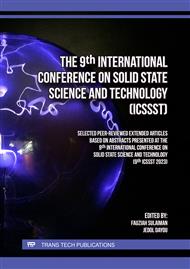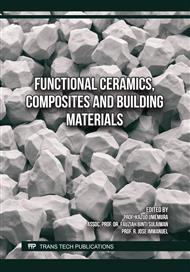[1]
Jusoh N, Yeong Y.F. Lau K.K, Mohd Sharif A.. Current development and challenges of mixed matrix membranes for CO2/CH4 separation, Sep Purif Rev 2016;45:321-344
Google Scholar
[2]
Margeta, K.,Farkaš, A.. Introductory Chapter: Zeolites - From Discovery to New Applications on the Global Market. IntechOpen, 2020, p.1
DOI: 10.5772/intechopen.92907
Google Scholar
[3]
Pérez-Botella E, Valencia S, Rey F. Zeolites in Adsorption Processes: State of the Art and Future Prospects. Chem Rev. 2022; 122:17647-17695.
DOI: 10.1021/acs.chemrev.2c00140
Google Scholar
[4]
Muhammad M, Yin Fong Y, Mohamed Nazri N.S, Kok keong L, Azmi M.S. Accelerated Synthesis of dodecasil 3 rhombohedral (DDR3) zeolite cyrstals via hydrothermal growth coupled with ultrasonic irradiation method, RSC Adv 2015;29:22658-22664
DOI: 10.1039/c5ra00009b
Google Scholar
[5]
First E.L., Hasan M.M.F, Floudas C.A., Discovery of novel zeolites for natural gas purification through combined material screening and process optimization, AICHE J, 2014; 60:1767-1785.
DOI: 10.1002/aic.14441
Google Scholar
[6]
Fischer M., Bell R.G., Influence of zeolite topology on CO2/N2 separation behaviour: force field simulations using a DFT-derived charge model, J Phys Chem C, 2012, 116: 26449-26463
DOI: 10.1021/jp3099768
Google Scholar
[7]
Novembre, D., Gimeno, D. Del Vecchio A. Synthesis and characterization of Na-P1 (GIS) zeolite using a kaolinitic rock. Sci Rep , 2021, 11:4872
DOI: 10.1038/s41598-021-84383-7
Google Scholar
[8]
Sharma P, Song J., Han M, Cho Churl, GIS-NaP1 zeolite microspheres as potential water adsorption material: Influence of initial silica concentration on adsorptive and physical/ topological properties. Sci Rep, 2016, 6: 22734.
DOI: 10.1038/srep22734
Google Scholar
[9]
Albert B.R, Cheetham A.K, Adams C., Investigations on P zeolites: synthesis and structure of the Gismondine analogue, highly crystalline low-silica CaP, Mater, 1998, 21:127-132
DOI: 10.1016/s1387-1811(97)00058-9
Google Scholar
[10]
Oleksiak M.D, Ghorbanpour A.; Conato M.T, ; McGrail, B.P., Grabow, L.C., Motkuri R.K, Rimer J.D., Synthesis Strategies for Ultrastable Zeolite GIS Polymorphs as Sorbents for Selective Separations, Chem, 2016, 22:16078-16088
DOI: 10.1002/chem.201602653
Google Scholar
[11]
Moldonado M, Oleksiak M.D., Chinta S., Rimer J.D., Controlling crystal polymorphism in organic-free synthesis of Na-zeolites, J. Am. Chem. Soc., 2013, 135:2641-2652
DOI: 10.1021/ja3105939
Google Scholar
[12]
Run M, Wu S., Wu G., Ultrasonic synthesis of mesoporous molecular sieve, Micropor Mesopor Mat., 2004, 74:37–47
DOI: 10.1016/j.micromeso.2004.06.003
Google Scholar
[13]
Zhou R., Zhong S, Lin X., Xu N., Synthesis of zeolite T by microwave and conventional heating, Micropo Mesopo Mat, 2009, 124:117–122
Google Scholar
[14]
Jhung S.H., Jin T, Kim Y.H., Chang J.-S., Phase-selective crystallization of cobaltincorporated aluminophosphate molecular sieves with large pore by microwave irradiation, Micropo Mesopo Mat. 2008, 109:58–6
DOI: 10.1016/j.micromeso.2007.04.031
Google Scholar
[15]
Askari S., Halladj R., Ultrasonic pretreatment for hydrothermal synthesis of SAPO-34 nanocrystals, Ultrason Sonochem 2012, 19:554–559.
DOI: 10.1016/j.ultsonch.2011.09.006
Google Scholar
[16]
Wu J., Wang B., Li N., Xiang S., Effect of Aging with Ultrasound on the Synthesis of MCM-49 Zeolite, Chin. J. Catal, 2006, 27 :375–377.
DOI: 10.1016/s1872-2067(06)60021-1
Google Scholar
[17]
Kim H.N., Suslick, K.S., The Effects of Ultrasound on Crystals: Sonocrystallization and Sonofragmentation. Crystals 2018, 8: 280.
DOI: 10.3390/cryst8070280
Google Scholar
[18]
Goel, S., Wu,Z., Zones, S.I, Iglesia, E. Synthesis and catalytic properties of metal clusters encapsulated within small-pore (SOD, GIS, ANA) zeolites, J Am Chem Soc, 2012, 134:17688
DOI: 10.1021/ja307370z
Google Scholar
[19]
Azizi S.N., Daghigh A.A., Abrishamkar M., Phase transformation of zeolite P to Y and analcime zeolites due to changing the time and temperature, J Spectrosc, 2013, 2013:1-5.
DOI: 10.1155/2013/428216
Google Scholar



